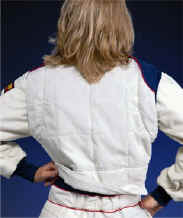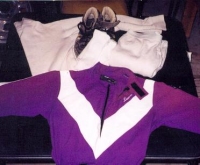

|
www.thundervalleyracing.com
|
|
|||||||||||||||||||
|
by Laurel Viera
"The price of those racing gloves is $75?," the driver nearly shouted. Calmly, the salesperson replied, "Aren't your hands worth $75?" I have always tried to follow the philosophy of "safety first" on the racetrack. There are a variety of hazards in motorsports to protect yourself from. One of those is FIRE. Fire is not only the most dangerous hazard to a racer but one of the simplest to protect herself from. Protecting yourself from fire requires knowledge to make informed decisions about what or what not to wear. The basic functions of fireproof clothing is to insulate the skin from the intense heat of a fire and to maintain the material's basic integrity and after that, it must allow for movement and be tolerable to wear. The very first fireproof clothing was made out of cotton and treated with Borax and the second suits to come along, were cotton treated with Proban. Unfortunately, through washing, they lost their fire resistance. Proban is still widely used today and racers must be careful on how they clean their clothing even though the chemical used today tests much better than when it was first developed. It still may lose its' fire resistance without warning if you are using the washing machine to clean with. In the early 60s, fire resistant fibers were developed. Dupont showcased Nomex and then Kevlar, which soon was followed by Celanese's PBI fibers. These are fibers that are woven into fire-resistant fabrics and then sold to the manufacturers.
Filament Nomex or Nomex I was the "new" fabric to be used for fireproof clothing but it had a tendency to shrink and crack in a fire in just a few seconds. So Dupont developed Nomex III, which was combination of 95% Nomex and 5% Kevlar. PBI fibers are, by far, the best fire wise but lack strength, so these fibers are interwoven with Kevlar. It is far superior to Nomex III but is very expensive and your only color choice is, light brown. Just recently, several developers have been creating a new fire resistant fiber from carbon, CarbonX by Chapman Thermal Products and a similar fiber by Carbon Cloth Technologies. It will be exciting to see what level this new fiber can take fire safety to. Ratings for fireproof clothing are done by two different standards. One is the SFI Foundation and the other is used by firefighters and the military and is called TPI or Thermal Protective Performance. Keep in mind while looking at this chart, that your skin blisters at 130 degrees and gasoline burns at 1800+ degrees Fahrenheit. It is also recommended that a racer wear nothing below an SFI rating of 5 and that requires, not just a firesuit, but layers of clothing including racing underwear, socks, gloves, shoes, headsock & helmet.
Now that you are armed with the basic knowledge of fireproof materials, the next step is to discuss how you put that knowledge to use. Layers, layers & more layers should be your motto. When you want to protect yourself from the elements, you wear layers. Not only can you assure the safety of a driving suit by the SFI rating but the more layers the suit has, the better the protection. And underneath that triple layer driving suit should be another layer of long underpants & shirt. Since racing has long been a "man's" world, the availability of long underpants/shirts for racing women has been limited to small, medium and large, in men's sizes. The other dilemma that I have had over the years has been underwear and bras. After doing a lot of questioning, the best I could come up with, in the past, has been cotton underwear and sportsbras and even these are never 100% cotton.
But, as of December 2000, Lady Eagle Wear, (formerly Lady D Safetywear & division of Design 500) is offering safetywear specifically made for women by a woman. Kathleen Standley, who has worked with Design 500 since 1988, began developing a line of undergarments for racing women after a supplier suggested that there was a need in the racing world. Lady Eagle Wear offers "Undercover", a line that includes long underwear, sports bras, panties & bicycle shorts. They also offer driving suits for a woman's figure.
Now that you have your triple layer firesuit, panties, bra, long underpants & shirt, you need to add the layers of socks. I usually wear 2 pairs with my racing shoes, since if there is an engine fire, my feet will probably be the first to be exposed. Next are your gloves and last, but not least is the headsock & helmet. Make sure your helmet has a Snell rating and not an M rating. M is for motorcycle and the inside lining is not made with Kevlar and is not fireproof. If you are dressed properly, you are ready to go racing! Arming yourself with even the basics of any subject will give you more control over what happens to you, especially in the area of keeping yourself safe, so remember….As you "suit up" to race, every body part you have is worth more money than you will ever have to spend to protect it. |
|
Home
| Member Area
|Meet the Racers
| Features
| News Articles Sponsorship
| Press Room
| Resources
| About Us
| Contact Us
|



